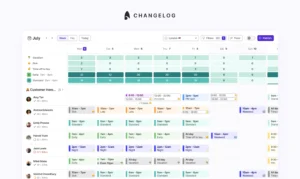
Streamlining support team schedules for success

The weekly task of team planning is always difficult, but do your old scheduling techniques reflect the high levels of service you want to deliver?
Streamlining the scheduling process will benefit your team by maximising success and minimising chaos.
Why you should improve your scheduling
Save your team’s time and resources
You might be wasting your team’s time and energy with outdated workforce management practices. Cross-channel coordination to collect agent preferences and availability are painstaking. Hour-by-hour demand for employees fluctuates.
Optimising the forecasting and scheduling processes cuts waste and expenses associated with under or overstaffing. Doing so, you can operate faster and can dedicate resources to more important tasks.
You want the capacity to be flexible
Any schedule planner knows and fears the possibility of unforeseen circumstances. Your best made plans are often cast aside by a sick day or technical issue, leaving your team scrambling and your customers unhappy. Schedule edits are extremely disruptive, with knock on effects putting out multiple people. By creating streamlined, agile schedules, you can stay ahead of problems to deliver consistent results to meet your SLAs.
See how Mercuryo’s flexibility helped them achieve a 90%+ service level.
You want to boost the happiness of your team
Your team’s happiness is crucial towards meeting your SLAs and satisfying your customers. But outdated scheduling which takes time, isn’t adaptable, or unfairly distributed tasks can frustrate your team. These methods aren’t built for modern teams that prioritise adaptability and fairness.
Imagine being a CS manager who spent hours creating the perfect schedule, only to then receive multiple change requests. A survey in 2023 revealed that over 60% of shift workers didn’t have the flexibility in their schedules to accommodate their needs. Streamlining the shift planning process ensures team members will go into their shifts with the energy and morale, ready to help customers with positivity and efficiency.
How you can start streamlining
Now you know why businesses are increasingly turning to workforce management software. Moving away from spreadsheets, these solutions can modernise your schedules by incorporating multiple key features.
Link-up your communication
Communication is key for organising your teams. Facilitate open dialogues to accommodate individual preferences and promote a collaborative environment. Integrating personal calendars and messaging creates a one-stop hub for all scheduling-related communication. In the event of a last-minute change, everyone’s on the same page and has time to plan. You won’t find yourself scrambling to find cover and your employees will be prepared to deliver with high morale.
Scheduling software helps foster this communication. Employees are empowered to organise and request their own shift swaps. All managers have to do is approve them, allowing changes to be made much more easily.Surfboard’s integration with Slack, for example, offers seamless communication between teams by updating surfers on schedule changes.
Use round robins to balance fairness and coverage
Not all shifts are created equal. Inevitably, team members repeatedly placed on unpopular shifts like weekends or early mornings won’t feel that they were scheduled fairly. It’s difficult to track which members have done which shifts, and added difficulty may come from some employees who have inflexible personal lives.
By planning these supplementary shifts in rotations, you’re able to fairly cycle team members through the same shifts. Each pattern restarts after a member has completed it, spreading workloads fairly across your team.
Surfboard’s Round Robin scheduling tool can consider time off in lieu, protecting your team from contract breach and giving them their deserved time off. Additionally, visibility from round robin scheduling provides information to what shifts your team will be working farther in advance.
Plan ahead through workforce forecasting
No matter what industry you’re in, your customer service team will inevitably face peak times. Whether it’s Christmas or a product launch, you need to know when to staff up to prepare for heavier workflows.
Get ahead of times which require extra staffing by forecasting demand. Utilise historic ticket data to gain insight into where you’ll need to allocate extra staff, to avoid last-minute schedule changes or unnecessary overtime.
During these peaks, high customer-service standards will be more important to upkeep than ever. Tools like Surfboard use integrated forecasting to ensure that you have the staff available to give your customers the help they seek.
Scheduling to meet your goals
Each member of your team has a unique skill set within their role, and a unique opportunity to add value to your workforce. Boost the performance of your team by managing KPIs, tracking their skills and successes over time.
Key metrics to measure include productivity, shrinkage, and service level performance. Depending on your business goals, certain metrics may be more important than others. What’s important is that your schedules are designed to meet these targets, prioritising what matters most.
Unsure which metrics to monitor? Here’s a guide to help you.
By monitoring the performance of your team through relevant data, you set yourself up to further optimise your schedules. A loop of constantly tracking success and iterating schedules accordingly ensures you optimise schedules for peak team performance, while minimising waste.
Workforce management software is a powerful tool to measure these metrics, allowing you to make data-driven decisions when planning your schedules.



